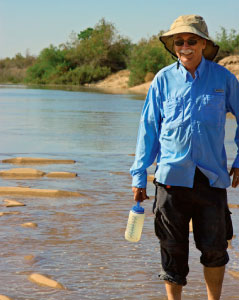In the News: Flessa ’68 Helps Restore Colorado River
 “It’s tremendously gratifying … the highlight of my career,” Karl Flessa ’68 told an NPR reporter in early April as he witnessed the Colorado River flowing toward the Sea of Cortez, an event that has not happened for most of the past 50 years.
“It’s tremendously gratifying … the highlight of my career,” Karl Flessa ’68 told an NPR reporter in early April as he witnessed the Colorado River flowing toward the Sea of Cortez, an event that has not happened for most of the past 50 years.
The March 23 pulse flow release of 130 million cubic meters of water from Morelos Dam—which mimicked a natural spring flood—was the culmination of decades of work by environmental nonprofit groups and scientists. The passage of Minute 319, an unprecedented agreement between the United States and Mexico, promises to deliver five years of pulse flows to the parched delta of the Colorado River.
Flessa, professor of geosciences at University of Arizona–Tucson, is co-chief scientist for the study of the results of the pulse flow, coordinating dozens of other scientists. He holds a doctorate in geology from Brown University.
“We are examining deposits of mollusk shells, bones of marine mammals, and otoliths of fish in order to assess the impact of upstream water diversions on the delta and estuary of the Colorado River,” he says. He also uses oxygen isotopes in dated clamshells to compare the variation in river flow during the past 1,000 years to the variation evident in the 100 years of the instrumental record.
The goal of Minute 319 is to restore native marshland, vegetation, and wildlife: cottonwood, willow trees, Yuma clapper rails, migratory warblers, Southwestern willow flycatchers, and more.
Flessa, a geology graduate, says, “Small classes and opportunities to do research in my second year were important in my career development.”
—Sharon Sanders